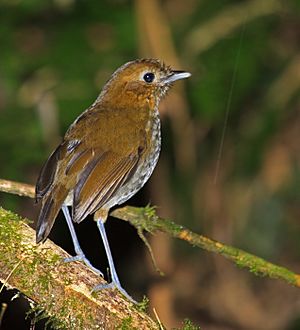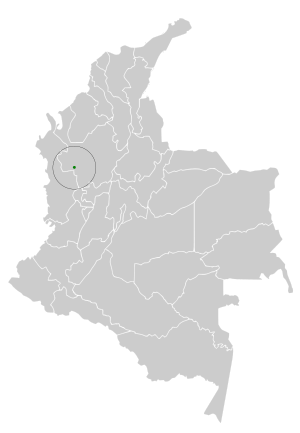Urrao antpitta facts for kids
Quick facts for kids Urrao antpitta |
|
|---|---|
 |
|
| Conservation status | |
| Scientific classification | |
| Genus: |
Grallaria
|
| Species: |
urraoensis
|
 |
|
| Synonyms | |
|
|
The Urrao antpitta (Grallaria urraoensis), also called Fenwick's antpitta, is a very rare bird. It lives in the cloud forests high up in the Andes mountains of Colombia. This bird is considered a critically endangered species.
Scientists first described this bird using the name Grallaria fenwickorum. Soon after, another group published a description with the name Grallaria urraoensis. There was some debate about which name was correct. However, many experts, like the International Ornithological Congress, now use G. urraoensis. Some people suggest calling it the Antioquia antpitta to avoid confusion.
Contents
Discovery of the Urrao Antpitta
This new bird species was first found in September 2007. It was during bird banding sessions. Diego Carantón, a researcher, caught an unfamiliar Grallaria antpitta. He was working for a group called Fundación ProAves de Colombia.
The bird's sounds were also recorded in late 2008. Scientists thought it was a new species. It was added to Colombia's bird list in 2009 as "Grallaria sp." Many bird watchers and scientists have since seen and studied this bird. They often see a family of them at a feeding station.
Luis Felipe Barrera and Avery Bartels wrote the first description. They named it Grallaria fenwickorum. Their description was based on feathers from a living bird. They also used information from two birds Carantón had collected earlier.
The feathers used for the first description were from a living bird. This bird was banded, photographed, and recorded. It was then released on January 11, 2010. The feathers were meant to be kept at a museum. However, the museum did not have the right facilities for such a sample. So, the feathers were sent to the proper authorities for safekeeping.
Two other bird specimens were collected earlier by Carantón. One of these birds died in a mist net by accident. These specimens were collected without the knowledge or permit from the local government. Because of this, they were not used as the main "holotype" for the first description. One of these specimens was later used for the second description of the species. This was done by Diego Carantón-Ayala and Katherine Certuche-Cubillos. They gave the bird the name Grallaria urraoensis.
Taxonomy and Naming
Taxonomy is how scientists classify living things. The Urrao antpitta belongs to the Grallaria group. It has small wings and plain feathers. Its legs are also quite long.
It seems to be most closely related to the brown-banded antpitta, G. milleri. They have similar voices and sizes. Some scientists think it's related to a subspecies called G. m. gilesi. Others believe it's more like G. m. milleri. Scientists also think this bird, the brown-banded antpitta, and the Cundinamarca antpitta are all closely related. This group is called a clade.
The name Grallaria comes from a Latin word meaning "stilts." This refers to the bird's long legs. The name fenwickorum honors George Fenwick and his family. They helped buy land for the Colibri del Sol Bird Reserve. This reserve is where the bird lives. The Spanish name Tororoi de Urrao comes from the town of Urrao. Tororoi is a common Spanish name for antpittas.
Description of the Urrao Antpitta
The Urrao antpitta looks a lot like the brown-banded antpitta. That bird lives only in the Cordillera Central of Colombia. But the Urrao antpitta has a slate-grey chest. It does not have the brown sides or chest band seen on the brown-banded antpitta.
Adult birds weigh about 53.5 to 57.4 grams (1.9 to 2.0 ounces). Their wings are about 95 to 99 millimeters (3.7 to 3.9 inches) long. Their tails are 57 to 63 millimeters (2.2 to 2.5 inches) long. Their legs are 44.5 to 49.9 millimeters (1.8 to 2.0 inches) long. Male and female Urrao antpittas look very similar. This is common for most antpitta species.
A young bird, called a fledgling, was covered in dark grey down. It had brown edges on its feathers. Its belly was buff-colored. Its feet were dark pink. Its beak was black on top and orange underneath. It had bright red-orange edges.
A slightly older young bird, called a juvenile, looked scaly. It had patches of black down with chestnut edges. These were mixed with grey feathers. Its belly was buff. Its beak looked like the fledgling's.
The Urrao antpitta's song has three notes. Each note gets longer and higher pitched. They sing more often early in the year. Their call is a single note. It is higher pitched than the song. The call rises, falls, and then rises again. They often make this call when they hear loud noises. They also call when they hear recordings of their own sounds. They call more later in the year. Both their song and call are similar to the brown-banded antpitta's. However, the Urrao antpitta's notes are shorter and lower. The notes in its song are also spaced farther apart.
Distribution and Habitat
This bird is only known to live in the Urrao area. It is found in and near the Colibrí del Sol Bird Reserve. This reserve is about 28.52 square kilometers (11 square miles) in size. It is on the side of the Páramo del Sol massif. This area is about 55 kilometers (34 miles) west of Medellín, Colombia. Medellín is Colombia's second-largest city.
The Páramo del Sol has over 27 square kilometers (10 square miles) of untouched páramo and Polylepis woodland. This is more of this habitat than all other páramos in the region combined. The Urrao antpitta lives in high mountain cloud forests. These forests have many Colombian oak trees. They are found at altitudes of 2,600 to 3,300 meters (8,500 to 10,800 feet) above sea level. Most of their territories have thickets of Chusquea bamboo. Scientists think its range might be bigger. But so far, surveys have not found it anywhere else.
Behaviour
The Urrao antpitta acts like other birds in its group. It is a shy bird. It looks for insects, especially beetles, on the ground. It searches in the leaf-litter under the trees.
It will fly up to higher branches, about 1.5 meters (5 feet) off the ground, to sing. It is most active and vocal in the hours after sunrise and before sunset.
These birds usually live in pairs. Sometimes they are seen alone. One group of three birds has also been observed.
Reproduction
Male birds caught in February and March showed signs of being ready to breed. This means their breeding season starts early in the year. It might begin as early as January and last for several months.
A fledgling and an adult bird with old brood patches were seen in June. This also suggests that the breeding season extends for several months.
Like other Grallaria species, the fledgling was not fully developed when it left the nest. Both parents fed it earthworms.
Conservation Status
The Urrao antpitta lives in a very small area. It is only known from the Colibrí del Sol reserve and nearby places. Other surveys in similar habitats have not found this bird.
Also, much of the habitat where this bird lives has been cleared. It has been turned into land for pasture. The area is also rich in minerals, which could lead to more habitat loss.
Scientists have found about 24 areas where these birds live. This suggests there are about 57 to 156 pairs of birds in total. Both scientific articles about this new species suggest it should be listed as critically endangered. The IUCN will follow this recommendation. Even though it is protected in the Colibrí del Sol reserve, it needs more help to survive. A single bird or pair that was known outside the reserve has not been seen since mid-2010. It seems they have disappeared.
See also
 In Spanish: Tororoí de Urrao para niños
In Spanish: Tororoí de Urrao para niños


